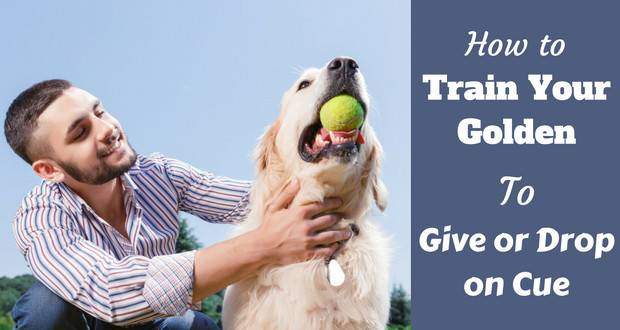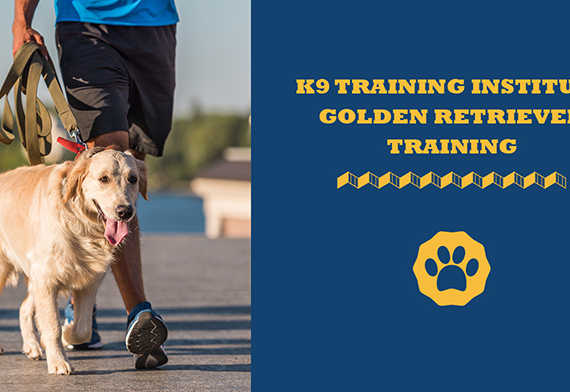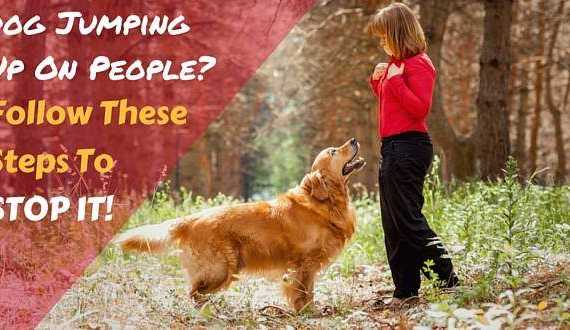Updated: August 9th, 2022

© Depositphotos.com / Dmyrto_Z
All dogs are different but if there’s one thing that every Golden Retriever loves doing, it’s putting things in their mouth. Usually this is playful and harmless — chewing on their favorite toy, for instance — but sometimes you’ll catch them gnashing down on something inappropriate, like your brand new pair of shoes!
While it’s impossible to completely stop your Golden picking things up and chewing on them, we can manage this behavior by training them to drop whatever they’re holding at your command.
The ‘give’ or ‘drop’ command (we’re going to use ‘give’) is one of the most important commands to teach as part of your dog’s training. As well as stopping them wreaking too much destruction on your shoes, it could also save your pup from ingesting something dangerous that they could choke on.
As long as you commit to regular training, your Golden should have no problem picking up the ‘give’ command. Let’s find out how…
Make Sure Your Behavior is in Check
First things first, we need to make sure that both you and your dog are going into this training with the right attitude. That’s right; you too!
As with all dog training, a calm, kind and patient approach is key to teaching ‘give’. It’s easy to frame this training as a punishment, especially if your pup is chewing on something they shouldn’t be, but any shouting or aggressive behavior from you can push your dog into aggressively resource guarding, which should be avoided at all costs.
Instead, you should try and create an environment where your dog is willing to give up whatever item is in their mouth, and not giving it up because they’re scared of punishment.
Before you start ‘give’ training, you should make sure your dog is ready to learn too and isn’t already resource guarding. If they do start acting aggressively when they have something in their mouths, it’s best to consult your vet or a behavioral psychologist for additional help. Attempting to train a resource-guarding dog without professional help is a recipe for an unsafe environment.
The Trick is to Trade
During the first stage of ‘give’ training, you’ll need to persuade your Golden that a ‘good thing’ will happen if they obey your command and drop whatever is in their mouth. In essence, you need to trade them something for their item.
The ‘good thing’ that you’re trading in this case is a treat – ideally a treat that they much prefer to whatever toy or item they’re currently chewing.
Understanding the Value System
When you’re assembling your tools ready to start training, you should have some understanding of your dog’s value system — i.e. how much your dog enjoys certain types of treats, chews and toys over others.
At this early stage of training, you’ll need some very high-value treats that you know your dog will be eager to give up their chew toy for. This will probably be something moist and pungent — some chicken or turkey, perhaps.
Next, you should choose the toy which you will try to trade the treat for. In order to make it as easy as possible, make it a low to mid-value toy that your dog likes, but doesn’t love. The aim is to set them on an early path to success.
As your training progresses and your dog gets better at learning the ‘give’ behavior, you will be able to experiment with different value treats and toys. This will help to train them against a variety of different scenarios.
The final thing you may want to have in your training tool kit is a clicker, or other similar tool to help mark the command and response. Here’s a guide to training ‘give’ while using a clicker.
Step by Step Guide to ‘Give’
During the first stage of ‘give’ training, you’ll need to use your treats every time you practice. The aim is to condition your Golden into believing that obeying your command and dropping their toy will bring about a good thing – a treat.
Here’s what the first few times practicing this command should look like:
- Give your dog the low to mid-value chew toy that you chose earlier, and allow them to play with it in their mouths for a few minutes.
- When you want them to give you the toy, show them the high-value treat you have in your hand and simultaneously say your command – ‘give’.
- At this point, they’re likely to drop the toy and go in for the treat, thanks to the established value system. When they do, give them the treat and some praise, while picking up the discarded toy in your other hand.
- If you use a clicker, be sure to click when they drop the toy.
- Wait for them to finish their treat and then return the toy.
- Repeat a couple of times until they no longer want to play with the toy.
After a few solid training sessions, your dog will reach the stage where they know the drill and can produce the required behavior literally on your cue. At this point, it’s time to notch it up a gear and ask them to drop their toy even when you’re not visibly offering them a treat.
You’re now working to wean them off the bribery model. The steps are more or less the same:
- Give your dog the same toy to chew on and play with again.
- Say ‘give’ again after a few minutes, but this time don’t show them the treat – instead keep it hidden in your hand or pocket.
- When they drop the toy as they’ve been conditioned to do by this point, praise them and give them the hidden treat. You can use your clicker when they drop.
- Again, remove the dropped toy with your other hand and return it once they’ve finished the treat.
- Repeat until your dog doesn’t want to play with the toy anymore.
If Your Dog Won’t Drop…
If your dog refuses to drop their toy once you remove the treat from their line of sight, then simply go back and practice with the treat upfront again a few times. There’s no shame in working slowly, at your dog’s pace.
If they’re refusing to drop even when they can see the treat, then you probably need to change the tools you’re working with. Remember the value system we discussed earlier? You should now pick a lower value toy for them to chew on and an even higher value treat that they will be happy to trade their toy for. Or, you could swap out the treat for a high-value toy instead.
To make the treat even more appealing to your pup, you could schedule your training at a time of the day when you know your dog is starting to get hungry. They’ll be more likely to go for the treat if they’re looking forward to dinner.
If they’re still not playing ball and dropping their toy, then some trainers recommend simply out-waiting them, resolving never to take the toy forcibly from their mouths. Hopefully, your dog should catch on reasonably quickly that they’re required to do something!
Next Steps for Your Dog to Give Anything, Anywhere
Once you’ve successfully conditioned your Golden to drop their toy when they hear ‘give’, it’s time to start proofing the behavior against different scenarios.
Dogs are unable to generalize and may get confused if they’re suddenly asked for a certain behavior in a new environment that they haven’t practiced in. That’s why it’s important to ‘proof’ your training — i.e. practice the command in lots of different places with different objects.
Stop Treating Every Time
Firstly, stop treating your dog every single time they follow the command, and simply reduce it down to once every two or three times that they obey instead.
As long as they manage to keep up this behavior, you can keep reducing the amount you treat them until it’s simply on an ad-hoc basis. This is called intermittent reinforcement and is a proven way to keep your dog’s interest in continually following your commands.
Vary Items to be Given and Value of Alternatives
Next, you should experiment with different toys and chews for them to hold in their mouth. These should get progressively higher value so it becomes more challenging for your dog to drop it when asked to do so.
When you start practicing with different objects, however, make sure that you don’t experiment with ‘forbidden’ or dangerous items like shoes or bones. Your dog may start to think they get a treat if they start chewing on a shoe!
You can also experiment with the value of the treats, maybe occasionally offering something of lower value, like kibble, and occasionally something delicious like chicken. In keeping with the intermittent reinforcement method, sometimes just offer praise or a scratch instead of a treat.
Vary the Environment and Setting
Now it’s time to practice ‘give’ in different settings, like other rooms of your house, in the yard and even when you’re out and about.
Start changing your position when you give the command too, so you’re not always directly in front of your Golden. This is particularly important for emergency situations as you want to be able to command them from far away, for instance, if you see that they’ve picked up something dangerous in the yard.
Essentially, you should be looking to practice this behavior whenever and wherever you can, regardless of whether it’s in your allotted training time. The more situations your dog practices in, the better they’ll learn the behavior.
One thing that should always stay constant and never change, however, is the exact command you say. If you start your training by saying ‘give’ but then later change it to ‘drop it’, your pup is likely to get confused and not know what to do next. It doesn’t matter what you say, just that you always say it the same way.
How Long Will Give Training Take?
The time to successfully train your Golden to ‘give’ will vary from dog to dog, with younger and more intelligent dogs likely to be much quicker to adopt the behavior than their older counterparts.
Providing that you train your dog consistently – by which we mean for a short period every day – you should see results in a couple of weeks.
Remember that once your dog learns the correct behavior, that doesn’t mean that the training period is complete, just that you need to move into maintenance mode. That means proofing ‘give’ in lots of different environments and treating them occasionally when they obey.
Consistency is Key
As always with any type of dog training, the key to success is always consistency.
Allow for around 15 minutes of training per day, which you should break into shorter increments of around 5 minutes each and space throughout the day. Some dogs may be able to tolerate more than this, but some will struggle even with 5 minutes at a time — always listen to your dog and tailor their training to their needs and capabilities.
In terms of specifically training the ‘give’ command, somewhere in the region of 10 repetitions per day is often recommended. Of course, you don’t have to do it 10 times within one training session – often, opportunities to practice crop up multiple times in a day thanks to Goldens’ love for putting things in their mouths!
Never overdo the training and always try to stop before your dog gets tired or bored – this will mean that next time, they’ll be eager to get going again, instead of being annoyed at having to practice again.
Puppies and younger dogs generally have much shorter attention spans than older ones, so adjust your training schedule accordingly.
Work at Your Dog’s Pace
There’s never any point in rushing training with your Golden Retriever. It’s a marathon, not a sprint, and good results will come in slow and steady. Patience is key!
If you’re worried that your dog isn’t ‘getting it’ or seems to be forgetting what you’ve already taught them, simply go back to previous steps and repeat. In this case, that means using higher value treats and lower-value chew toys. Never voice any frustration or annoyance with your dog as this will only confuse and potentially set back them further. They are eager to please you, so make it as easy as possible for them to learn and be successful.
‘Give’ in an Emergency
Hopefully, at this point your dog will be well versed on dropping whatever is in their mouth once they hear you give the command. Ideally, you want to get them to the stage that even though they haven’t practiced dropping, say, a razor blade that they’ve picked up in the bathroom, they will do so as they recognize the command and know what their required behavior is.
However, we don’t live in an ideal world, and sometimes your pup really won’t want to give up what they’re carrying — or perhaps they simply haven’t learned how to do so yet. Let’s say you spot your dog carrying a load of chicken bones in their mouth, which they’ve quietly retrieved from the trash while you’re cooking dinner.
If they don’t drop when you ask them to, and you’re worried about the myriad of choking hazards, you might need to safely pry their jaws open to retrieve the bones. This can be dangerous, encourage aggression and even resource guarding in your dog so is reserved for emergencies only. It goes without saying that only responsible adults should attempt this.
Firstly, ensure that you act quickly and decisively – don’t allow your dog the time to swallow something in your hesitancy. Apply even pressure on both the top and bottom of your dog’s jaws, pressing their lips against the teeth. At this point, your dog should reflexively open their mouth in order to avoid injuring themselves or biting their lips. You will then either need to tilt their head to draw the item out, or quickly remove it yourself.
Once the item has been removed, remember to praise your dog and treat them so they’re not scarred by the experience.
If you fear your dog is too aggressive for you to remove an item safely in emergency circumstances, you should consult your vet or a behavioral specialist for advice.
General Training Tips
Here are a few pointers for successful training sessions that should help with the ‘give’ command and other ones besides.
- Train somewhere quiet where you have the full attention of your dog – especially in the beginning stages. You want to ensure that they’re focused and not distracted.
- Keep all treats to a small, pea size amount to avoid overfeeding them.
- If any children are involved in dog training, make sure to always carefully supervise them and be especially careful with any commands that concern the mouth – that includes ‘give’.
- Always keep your tone and attitude light and friendly, and make sure that it doesn’t sound like you’re punishing your dog. After all, if your dog doesn’t understand a command, that’s your fault – not theirs!
Now all that’s left to do is to start the training – good luck!




2 Comments
Andrew
Learning takes time and lessons don’t always stick the first time. What seems like an easy thing to learn for you, might not make sense to your dog right away. Patience is a virtue.
JANET KOS
I think the writer gives detailed easy to do instruction, but saying you need a trainer trained in canine pyschology because he is resource guarding. I think ignoring him works best of all – its short and sweet and you are not teaching him he will get a treat simply by going after something he shouldn’t have. Goldens are smart and they catch on to this very quickly. I had one that would go to the door and my husband would get up and then he would walk toward the kitchen hoping to get a treat. They learn by repetition by you have to one step in front of them all the time. We rarely use treats when training and it pays off in the end. What happens when you are out in a field and he decides to run the other way toward traffic? This is when the command down comes in handy- practice on a long lunge line first. Safety first.